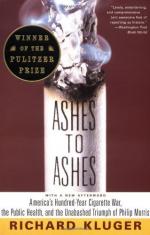
|
| Name: _________________________ | Period: ___________________ |
This test consists of 15 multiple choice questions and 5 short answer questions.
Multiple Choice Questions
1. Why do Marlboro Lights start off slowly?
(a) Lack of recognition.
(b) They have little flavor.
(c) Men do not trust them.
(d) The name makes it sound less appealing.
2. When does RJR general council Henry Ramm urge a more aggressive approach to the previous holding the line?
(a) When Clarence Little is replaced as scientific director of CTR.
(b) When Clay Little is replaced as scientifc director of CTR.
(c) When Clarence Little becomes the scienfic director of CTR.
(d) When Clay Little becomes the scientic director of CTR.
3. What do some in Congress pressure the EPA to do?
(a) Hide its findings.
(b) Dilute its findings.
(c) Strengthen its findings.
(d) Destroy its findings.
4. Why do some people see less toxic cigarettes as a middle ground?
(a) Smokers reap weightloss benefits but do not get cancer.
(b) Smokers stay addicted, but there are fewer cases of cancer.
(c) To seriously assist with the public health, while not provoking the wrath of the powerful tobacco companies.
(d) People can still smoke without getting cancer.
5. On what does The American Cancer Society sponsor smoking research in 1967?
(a) Poodles.
(b) Dalmatians.
(c) Chihauhaus.
(d) Beagles.
6. Johnson was seen as _____________ and the company's stock price suffered as a result.
(a) Nice.
(b) Eccentric.
(c) Crazy.
(d) Funny.
7. The success of what 1973 horse race opens a new era for sponsoring spectator sporting events?
(a) The Winston Derby.
(b) The Winston Cup.
(c) The Marlboro Cup.
(d) The Marlboro Derby.
8. Marketers wanted to release a low tar Marlboro, but did not want what to happen?
(a) Consumers to not trust the original cigarettes.
(b) Consumers to not like the taste.
(c) The image of the cowboy to change.
(d) The name "mild" to detract from the rugged image of the product.
9. A Californian congressman named Henry Waxman began doing what?
(a) Championing the anti-smoking cause.
(b) Helping the tobacco industry to regain ground.
(c) Championing the efforts of the tobacco industry to change.
(d) Encouraging the tobacco industry.
10. When advertising faltered, R.J. Reynolds officials start a practice known as trade-loading to do what?
(a) Artificially decrease its short term sales numbers.
(b) Artificially increase its short term sales numbers.
(c) Artificially increase its long term sales numbers.
(d) Artificially decrease its long term sales numbers.
11. In the late 1980s, as the first formalized studies of ETS (second hand smoke) were being fomented, Philip Morris decides to head off any damage by doing what?
(a) Getting out of the tobacco industry for good.
(b) Getting more involved in the food industry.
(c) Starting its own research center, the Center for Indoor Air Research (CIAR).
(d) Assisting the organizatio in their studies.
12. How does the industry respond?
(a) By challenging the legality of the entire proceeding under the warning label legislation of 1970.
(b) By giving in to Rose's lawyer's requests.
(c) By paying off the lawyer and ending the case.
(d) By giving Rose's family money to pay for her treatment and funeral.
13. What quickly became a prestigious health research institute?
(a) The American Healthcare Organization (AHO).
(b) The United States Foundation for Health (USFH).
(c) The United States Healthy Families Guild (USHFG).
(d) The American Health Foundation (AHF).
14. For what does Rose's lawyer work?
(a) To pay for Rose's treatment and funeral.
(b) To get money from the tobacco industry for Rose's family.
(c) Stronger laws against smoking.
(d) To show a pattern of distorting data and hiding negative evidence over the years that pushed the threshold of conspiracy.
15. At the same time, what are examined for the first time since the Great Depression?
(a) The links between cancer and nicotine.
(b) The air pollution caused by cigarettes.
(c) Tobacco federal subsidies.
(d) The addictive qualities of nicotine.
Short Answer Questions
1. Philip Morris made a successful buyout offer for _____________ in 1986.
2. A __________ study on the effects of smoke on rabbit lungs was abruptly shut down and the researchers' notebooks confiscated.
3. How does Rose's attorney counter the statements made about the extensive health warnings?
4. A lawyer named ____________, who had expertise in asbestos litigation, saw an opportunity to go after the tobacco industry, given recent New Jersey strict liability litigation.
5. What does Rose tell her attorney that she wanted him to do after her death?
|
This section contains 715 words (approx. 3 pages at 300 words per page) |

|




